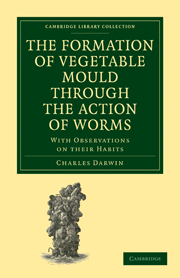Book contents
- Frontmatter
- Contents
- INTRODUCTION
- CHAPTER I HABITS OF WORMS
- CHAPTER II HABITS OF WORMS—continued
- CHAPTER III THE AMOUNT OF FINE EARTH BROUGHT UP BY WORMS TO THE SURFACE
- CHAPTER IV THE PART WHICH WORMS HAVE PLAYED IN THE BURIAL OF ANCIENT BUILDINGS
- CHAPTER V THE ACTION OF WORMS IN THE DENUDATION OF THE LAND
- CHAPTER VI THE DENUDATION OF THE LAND—continued
- CHAPTER VII CONCLUSION
- INDEX
CHAPTER V - THE ACTION OF WORMS IN THE DENUDATION OF THE LAND
Published online by Cambridge University Press: 29 August 2010
- Frontmatter
- Contents
- INTRODUCTION
- CHAPTER I HABITS OF WORMS
- CHAPTER II HABITS OF WORMS—continued
- CHAPTER III THE AMOUNT OF FINE EARTH BROUGHT UP BY WORMS TO THE SURFACE
- CHAPTER IV THE PART WHICH WORMS HAVE PLAYED IN THE BURIAL OF ANCIENT BUILDINGS
- CHAPTER V THE ACTION OF WORMS IN THE DENUDATION OF THE LAND
- CHAPTER VI THE DENUDATION OF THE LAND—continued
- CHAPTER VII CONCLUSION
- INDEX
Summary
No one doubts that our world at one time consisted of crystalline rocks, and that it is to their disintegration through the action of air, water, changes of temperature, rivers, waves of the sea, earthquakes and volcanic outbursts, that we owe our sedimentary formations. These after being consolidated and sometimes recrystallized, have often been again disintegrated. Denudation means the removal of such disintegrated matter to a lower level. Of the many striking results due to the modern progress of geology there are hardly any more striking than those which relate to denudation. It was long ago seen that there must have been an immense amount of denudation; but until the successive formations were carefully mapped and measured, no one fully realised how great was the amount. One of the first and most remarkable memoirs ever published on this subject was that by Ramsay, who in 1846 showed that in Wales from 9000 to 11, 000 feet in thickness of solid rock had been stripped off large tracks of country. Perhaps the plainest evidence of great denudation is afforded by faults or cracks, which extend for many miles across certain districts, with the strata on one side raised even ten thousand feet above the corresponding strata on the opposite side; and yet there is not a vestige of this gigantic displacement visible on the surface of the land. A huge pile of rock has been planed away on one side and not a remnant left.
- Type
- Chapter
- Information
- The Formation of Vegetable Mould through the Action of WormsWith Observations on their Habits, pp. 230 - 258Publisher: Cambridge University PressPrint publication year: 2009First published in: 1881



